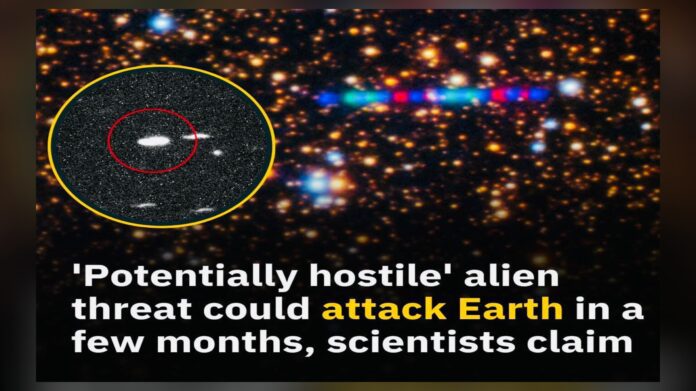Srinagar: A mysterious intergalactic object could potentially be a “hostile” alien spacecraft that’s slated to attack our planet in November, according to a controversial new study by a small group of scientists.
“The consequences, should the hypothesis turn out to be correct, could potentially be dire for humanity,” the researchers wrote in the inflammatory paper, which was published July 16 to the preprint server arXiv, South West News Service reported.
Dubbed 3I/ATLAS, the interstellar entity was discovered on July 1, rocketing toward the sun at more than 130,000 mph, Live Science reported. Less than 24 hours later, it was confirmed to be an interstellar object with initial observations suggesting that it could be a comet that measures up to 15 miles in diameter — larger than Manhattan.
However, in the new paper, the trio of researchers suggested that it might be a piece of extraterrestrial spy technology in disguise.
One of the researchers, Avi Loeb — a prominent Harvard astrophysicist known for linking extraterrestrial objects to alien life — previously made waves after floating the theory that 2017 interstellar object ʻOumuamua could be an artificial recon probe sent by an alien civilization, based on its odd shape and acceleration.
In this study, which he collaborated on with Adam Hibberd and Adam Crowl of the Initiative for Interstellar Studies in London, Loeb postulated that 3I/ATLAS’s trajectory suggests a similarly alien origin.
The trio felt the object’s speed — which was significantly faster than ʻOumuamua and other objects — and the fact that it entered our solar system from a different angle than its predecessors offer “various benefits to an extraterrestrial intelligence,” Loeb wrote in a blog post.
One benefit is that 3I/ATLAS will make close approaches to Jupiter, Mars and Venus, which could allow aliens to stealthily plant spy “gadgets” there, Loeb wrote.
When the so-called undercover UFO reaches its closest to the Sun (perihelion) in late November, it will be concealed from Earth’s view. “This could be intentional to avoid detailed observations from Earth-based telescopes when the object is brightest or when gadgets are sent to Earth from that hidden vantage point,” Loeb declared.
If this anomaly is a “technological artifact,” this could support the dark forest hypothesis, which argues we haven’t found signs of extraterrestrial entities because they are remaining undercover to shield themselves from predators or prey.
Loeb warns that this could suggest that an attack is likely and would “possibly require defensive measures to be undertaken.”
The problem is that 3I/ATLAS is traveling too fast for an Earth-based spacecraft to intercept it before it exits the solar system. “It is therefore impractical for earthlings to land on 3I/ATLAS at closest approach by boarding chemical rockets, since our best rockets reach at most a third of that speed,” Loeb wrote.
However, other scientists have thrown cold water on the so-called alien origins of the object, which they believe is a comet.
“All evidence points to this being an ordinary comet that was ejected from another solar system, just as countless billions of comets have been ejected from our own solar system,” added Samantha Lawler, an astronomer at the University of Regina in Canada who studies solar system dynamics, Live Science reported.
In fact, even Loeb admitted in his blog that his alien spy probe theory is a bit far-fetched: “By far, the most likely outcome will be that 3I/ATLAS is a completely natural interstellar object, probably a comet.”
The researchers also warned the public to take the paper, which has not yet been peer-reviewed, with a grain of salt.
“This paper is contingent on a remarkable but, as we shall show, testable hypothesis, to which the authors do not necessarily ascribe, yet is certainly worthy of an analysis and a report,” they wrote. “The hypothesis is an interesting exercise in its own right, and is fun to pursue, irrespective of its likely validity.”
However, critics have called their project a mockery of the work of other scientists, who have provided plenty of evidence that 3I/ATLAS is not evidence of a pending close encounter.
“Astronomers all around the world have been thrilled at the arrival of 3I/ATLAS, collaborating to use advanced telescopes to learn about this visitor,” Chris Lintott, an astronomer at the University of Oxford who helped simulate 3I/ATLAS’s galactic origins, told Live Science. “Any suggestion that it’s artificial is nonsense on stilts, and is an insult to the exciting work going on to understand this object.” (Agencies)

